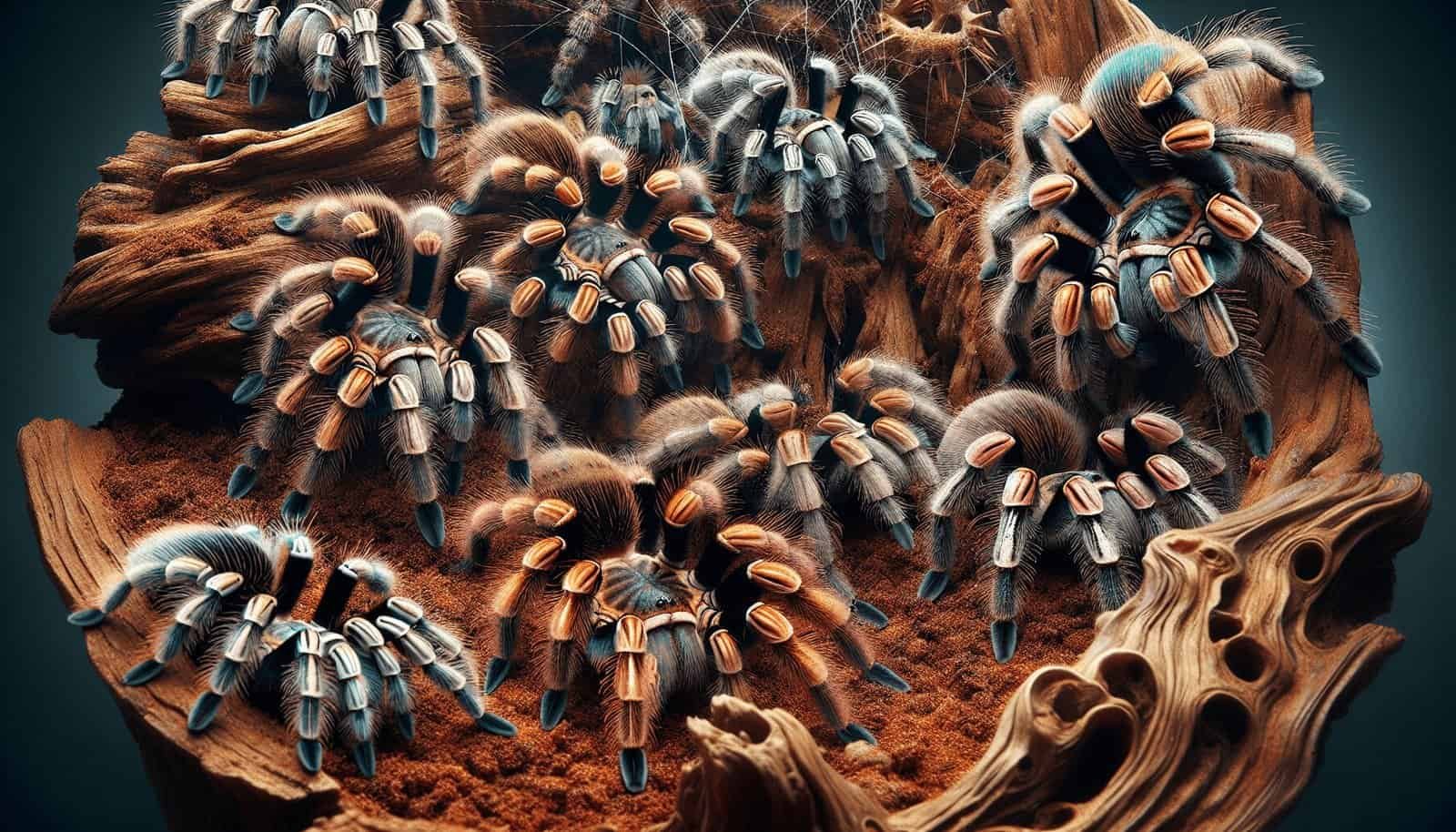In the realm of exotic pets, tarantulas have always sparked curiosity, not just for their unique appearance but also for their intriguing behaviors. When it comes to breeding these fascinating creatures, enthusiasts often debate whether a communal setup is feasible. This article explores the possibility and challenges of breeding tarantulas together, shedding light on their natural tendencies and the specific conditions needed to make communal breeding a success. You’ll discover expert insights and firsthand experiences that could guide you in creating a harmonious, multi-tarantula environment. Have you ever wondered if tarantulas can thrive and even breed in a communal setup? It’s an intriguing question for both seasoned arachnid enthusiasts and curious beginners alike. Let’s dive into the world of tarantulas and explore whether or not these fascinating creatures can be successfully bred in communal environments.
Understanding Tarantulas
Tarantulas are a diverse and captivating group of spiders, known for their large size, hairy bodies, and unique behaviors. They belong to the family Theraphosidae and can be found in various habitats around the world, from tropical rainforests to arid deserts.
Types of Tarantulas
There are many species of tarantulas, each with their own distinct characteristics and needs.
| Genus | Common Species | Geographic Location |
|---|---|---|
| Aphonopelma | Chalcodes, Anax | United States, Mexico |
| Brachypelma | Smithi (Mexican Red-Knee) | Mexico |
| Grammostola | Pulchra (Brazilian Black) | South America |
| Poecilotheria | Regalis (Indian Ornamental) | India, Sri Lanka |
| Avicularia | Avicularia (Pinktoe) | South America |
The Concept of Communal Setup
Before delving into the breeding aspect, it’s important to understand what a communal setup entails. Essentially, a communal setup involves housing multiple tarantulas together in the same enclosure. This setup can provide some benefits but also poses significant challenges.
Benefits and Challenges
Communal setups can be advantageous in terms of space-saving and creating more naturalistic environments. However, they also bring about challenges related to the natural solitary and territorial behavior of tarantulas.
Benefits
- Space Efficiency: Combining multiple tarantulas in one enclosure can save space and simplify management.
- Naturalistic Behaviors: In certain species, communal setups can encourage behaviors seen in the wild.
- Observation Opportunities: Watching interactions between individuals can be fascinating and educational.
Challenges
- Aggression and Cannibalism: Many tarantulas are solitary and may display aggression or cannibalistic behavior towards each other.
- Feeding Issues: Ensuring every individual gets enough food can be tricky.
- Disease and Parasites: Communal living can facilitate the spread of diseases and parasites.
Species Suitable for Communal Setups
Not all tarantulas are candidates for communal living. Certain species are more tolerant of living in close quarters with others of their kind.
Recommended Species
While many tarantulas are strict loners, a few species have been reported to do relatively well in communal setups:
| Genus | Species | Notes on Communal Behavior |
|---|---|---|
| Poecilotheria | Metallica, Regalis | Known for some success in community settings |
| Avicularia | Avicularia, Versicolor | Can sometimes be kept communally in large spaces |
| Monocentropus | Balfouri | Frequently cited as being more communal |
| Holothele | Incei | Often raised communally by hobbyists |
Species to Avoid
Similarly, some species are highly territorial and should be avoided in communal setups:
| Genus | Species | Notes on Territorial Behavior |
|---|---|---|
| Grammostola | All species | Known for being particularly solitary and territorial |
| Brachypelma | All species | High tendency for aggression towards tank mates |
| Theraphosa | Blondii (Goliath Birdeater) | Large size and aggression make communal setups impractical |
Preparing a Communal Setup
Creating a successful communal setup involves careful planning and attention to detail. Here is a breakdown of what you need to consider.
Enclosure Size and Environment
A communal setup requires a larger-than-normal enclosure to prevent conflict and provide enough resources for all inhabitants.
- Size: The enclosure should be spacious enough to allow each tarantula to establish its own territory.
- Hiding Spots: Provide multiple hiding spots and shelters to reduce stress and territorial disputes.
- Humidity and Temperature: Match the species’ natural habitat requirements, ensuring a stable microenvironment.
Feeding and Nutrition
Feeding multiple tarantulas in one enclosure can be a logistical challenge.
- Feeding Strategy: Implement a strategy that ensures all individuals have access to food. This may involve hand-feeding or using multiple feeding stations.
- Monitor Intake: Regularly check that all tarantulas are eating properly, as stronger individuals might monopolize food sources.
Health Monitoring
Keeping tarantulas healthy in a communal setup requires vigilance.
- Regular Checks: Conduct frequent health checks to identify signs of stress, disease, or injuries.
- Isolation Protocols: Have a plan in place to isolate injured or stressed individuals if needed.

The Breeding Process
Breeding tarantulas in a communal setup is intricate and requires understanding their reproductive behaviors.
Mating Rituals
Tarantula mating involves complex rituals that are fascinating to observe but can also be risky.
- Male Introduction: Introduce males to the communal enclosure carefully. Males in search of mates may face aggression from both females and other males.
- Courtship: Males perform courtship dances and drumming to signal their intentions to females.
Post-Mating Care
After mating, females may require special care.
- Egg Sac Production: Provide a stable environment for females to produce and care for egg sacs.
- Hatchlings: Once the eggs hatch, young spiderlings will need proper care and feeding.
Potential Pitfalls
Breeding in communal setups can lead to several complications.
- Cannibalism Risk: Males are often at risk of being cannibalized by females after mating.
- Overcrowding: A successful breeding can quickly lead to overcrowding, necessitating expansion or individual rehousing of spiderlings.
Case Studies and Real-World Examples
Looking at real-world examples can provide valuable insights into the feasibility of breeding tarantulas communally.
Monocentropus Balfouri
This species is frequently cited in communal breeding success stories.
- Case Study: Several hobbyists have reported success breeding Monocentropus Balfouri in communal setups without significant aggression.
- Method: These setups often include a large enclosure with plenty of hiding spots and a stable environment.
Avicularia Species
Success with Avicularia species varies but offers an interesting glimpse into potential communal breeding.
- Case Study: Some breeders have managed to raise Avicularia spiderlings communally, though with careful monitoring.
- Method: Emphasizing vertical space and plenty of foliage can mimic their natural arboreal habitat.

Ethical Considerations
Breeding tarantulas in a communal setup raises important ethical questions.
Welfare of the Tarantulas
Ensuring the well-being of each individual is paramount.
- Stress Levels: Monitor closely for signs of stress which can lead to health problems.
- Aggression Management: Intervening when aggression occurs is essential to prevent harm.
Conservation Implications
Responsible breeding can contribute to conservation efforts.
- Captive Breeding: Successfully breeding tarantulas in captivity can reduce the demand for wild-caught specimens.
- Education and Awareness: Breeding programs can help raise awareness and appreciation for these fascinating creatures.
Best Practices for Success
Implementing best practices can increase the likelihood of successful communal breeding.
Research and Planning
Knowledge is key to a successful communal setup.
- Species-Specific Research: Understand the specific needs and behaviors of the species you intend to breed.
- Setup Design: Design your communal enclosure with ample space, hiding spots, and environmental stability.
Patience and Vigilance
Breeding tarantulas communally is not a process that can be rushed.
- Monitoring: Regularly observe and note any changes in behavior, health, or environment.
- Adjustment: Be prepared to make adjustments to the setup as needed to ensure the well-being of all tarantulas.

Conclusion
So, can tarantulas be bred successfully in a communal setup? The answer is nuanced. While some species have shown promise in communal breeding environments, others are best kept solitary. Understanding the benefits, challenges, and specific needs of the tarantula species you have is essential for success.
If you decide to venture into communal breeding, do so with thorough research, careful planning, and a commitment to the welfare of your arachnid companions. With patience and dedication, the captivating world of communal tarantula breeding can be both rewarding and enlightening.

